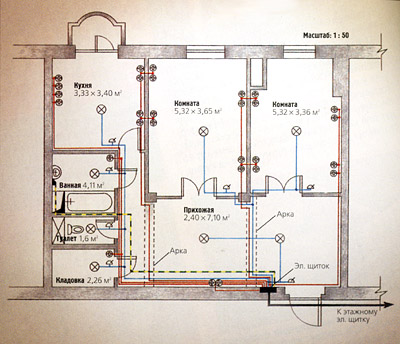Layout of electrical wiring, taking into account the places of installation of electrical appliances and lamps
What is wiring marking for?
The correct location of electrical wiring in the apartment is necessary, the house is determined in advance, guided by the proposed arrangement of furniture, household electrical equipment and lamps. It will help later avoid the use of extension cords, etc., which significantly reduce the level of safety when working with electrical appliances.
Electrical wiring marking requirements
When marking the wiring, it is necessary to take into account compliance with the norms for distances of electrical wiring elements from the floor and pipelines, window and door openings. The specifics of the premises (bathroom, workshop, garage) must be taken into account.
How to mark electrical wiring
Marking is done in one of two ways:
1) First, as a rule, they mark places for all elements (household appliances, lamps) in each room and other rooms in the house or apartment, and then mark the main sections going to the El panel;
2) First, they pass from the electricity meter panel and gradually move to rooms and other premises.
In each room, first of all, it is necessary to mark the places for installing electrical appliances, lamps, switches and sockets, as well as a place for a distribution box, which for each room is a source of power. The placement of electrical equipment can be marked directly on the ceiling and walls.

Electrical wiring layout when installing a ceiling lamp
If you need to install a ceiling lamp in the room, then it is installed in the center of the ceiling, which is located at the point of intersection of two diagonals drawn from opposite corners of the room. Straight lines for laying wires are cut off, as a rule, with the help of a cord or twine, pulled between two points a straight part of the line and previously rubbed with charcoal or chalk. Such work is best done with an assistant, who must attach a cable to one point, and you to another.
The cord stretched with a string is taken on two fingers at a distance of a meter from the end point and pull it from walls at a distance of 30-40 cm. When the cable is released sharply, it hits the wall and even leaves a copper or coal line. For this purpose, there are also special rosette roulettes, consisting of a nylon cord with a diameter of 2-3 mm and a length of 5-10 m. The tape has a supply of dye, which is filled with a gauze bag, fixed at the exit of the cable from the roulette.
Lines for single fasteners (rollers, fasteners, etc.) are marked in the centers of the installation of screws and screws, and under the brackets on two lines in the places of the brackets to be placed. In addition, steel tape measures, folding wooden or steel measuring instruments, compasses and other devices.
Marking work is carried out, as a rule, by two people from ladders installed at opposite ends of rooms. The layout of hidden wiring lines is simplified, as it does not require great accuracy when drawing horizontal and vertical lines.
After the end of the marking, before starting electrical work, complete fasteners depending on the type and method of carrying out electrical wiring, in addition, the accuracy of determining the places for installing pantographs and switching equipment is preserved for any type of electrical installations.
